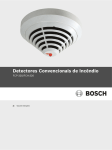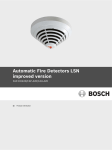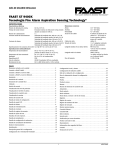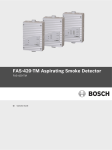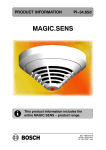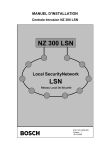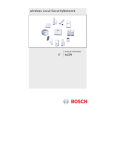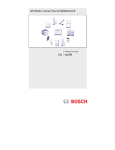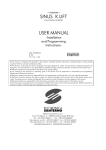Download Bosch FCP?320 Specifications
Transcript
Conventional Automatic Detectors FCP-320/FCH-320 en Operation Guide Conventional Automatic Detectors Table of Contents | en 3 Table of Contents 1 Product Description 5 2 System Overview 6 2.1 Configuration of the Detector 6 2.2 Functional Description of Sensor Technology 6 2.2.1 Optical Sensor (Smoke Detector) 6 2.2.2 Thermal Sensor (Heat Detector) 6 2.2.3 Chemical Sensor (Gas Sensor) 6 2.3 System Description 6 2.4 Features 7 3 Planning 8 3.1 Basic Planning Guidelines 8 3.2 Use in Fire Barriers Conforming to DIBt 8 4 Installation 9 4.1 Overview of Detector Bases 4.2 Mounting the Bases 11 9 4.3 Wiring 12 4.3.1 Wiring the MS 400/MS 400 B 12 4.3.2 Wiring the MSR 320 13 4.4 Detector Base Sounder 14 4.5 Installing the Detector Head 14 4.6 Detector Removal 15 5 Accessories 16 5.1 EOL Module for Line Termination According to EN 54-13 16 5.2 Support Plates for Detector Identification 16 5.3 SK 400 Protective Basket 16 5.4 SSK 400 Protective Dust Cover 17 5.5 MK 400 Detector Console 17 5.6 MH 400 Detector Heating Element 17 5.7 External Detector Alarm Display / Remote Indicator 17 5.7.1 Remote Indicator FAA-420-RI 18 5.7.2 External Detector Alarm Display MPA 19 5.8 Accessories for Service und Detector Testing 21 6 Order Overview 24 6.1 Detector Variants 24 6.1.1 Detectors with 820 Ohm Alarm Resistor 24 6.1.2 Detectors with 470 Ohm Alarm Resistor* 24 6.2 Detector Bases 24 6.3 Detector Accessories 24 6.4 Installation Accessories 25 6.5 Detector Base Sounders 25 Bosch Sicherheitssysteme GmbH Operation Guide F.01U.002.707 | 8.0 | 2011.10 4 en | Table of Contents Conventional Automatic Detectors 6.6 Service Accessories 25 7 Maintenance and Service 26 7.1 Coding of the Detector Types 27 7.2 Test Procedure for Detectors with C-Sensor 27 7.3 Test Procedure for Detectors without C-Sensor 28 7.4 Warranty 28 7.5 Repair 28 7.6 Disposal 28 7.7 Additional Documentation 28 8 Specifications 29 I Abbreviations 31 F.01U.002.707 | 8.0 | 2011.10 Operation Guide Bosch Sicherheitssysteme GmbH Conventional Automatic Detectors 1 Product Description | en 5 Product Description NOTICE! This Product Information describes the entire product range of the FCP-320/FCH-320 Conventional Automatic Fire Detectors. The FCP-320/FCH-320 Conventional Automatic Fire Detectors works on the basis of the conventional technology and combines standard detection methods such as scattered light measurement and temperature measurement with gas measuring technology at the highest configuration level. This method uses state-of-the-art processing methods to evaluate the signals from the gas sensor and scattered light sensor or thermal sensor. Security against false alarms is thus increased significantly and detection time is reduced in comparison with the fire detectors generally available on the market today. Thanks to the higher information content of the multisensor detectors, the use of detectors is possible in environments where pure smoke detectors cannot be used. The detectors are available in the following configuration levels: – FCP-OC320: Combined optical, gas-sensitive smoke detectors – FCP-OT320: Combined optical, thermal smoke detectors – FCP-O320: Optical smoke detectors – FCH-T320: Thermal detectors. The detector's timeless and innovative design is a result of the cooperation between engineers and designers. With this design it is possible to reconcile the contradictory goals of a generous installation space and a small detector. The placement of the individual display on the detector tip is the first externally visible characteristic of the installation-friendly development concept. The stable and robust detector base need no longer be aligned due to the position-independent position of the individual display. It is suitable for surface and flush mounting and includes separate mounting points for dropped ceiling and concealed sockets. In addition, it fits all common bore patterns. For surface mounting, the cable may be fed through on the side. The integrated strain relief for interfloor cables prevents the removal of cables from the terminal after installation. The terminals are easily accessible; a retainer for the end of line resistor is integrated. Cable diameters of up to 2.5 mm2 can be used. It can be equipped with a damp room seal so that all installation requirements can be covered with one base. The 320 Series detectors are available with either a 420 Ω alarm resistor or a 320 Ω alarm resistor. The operating voltage range is 8.5 V DC to 32 V DC, which allows the detectors to be used with almost every common conventional fire panel. Bosch Sicherheitssysteme GmbH Operation Guide F.01U.002.707 | 8.0 | 2011.10 6 en | System Overview Conventional Automatic Detectors 2 System Overview 2.1 Configuration of the Detector 1 Smoke measurement chamber with 2 Thermal sensor 3 Chemical sensor (covered on the cross- 3 4 optical sensor 2 1 section) 4 Individual display 5 PC board with evaluation electronics 6 MS 400 / MS 400 B Base 6 5 Figure 2.1 Configuration of the Detector 2.2 Functional Description of Sensor Technology 2.2.1 Optical Sensor (Smoke Detector) The optical sensor uses the scattered-light method. An LED sends light into the measuring chamber (refer to Figure 2.1, item 1); this light is absorbed by the labyrinth structure. In the event of a fire, smoke enters the measuring chamber. The light is scattered by the smoke particles and hits the photo diodes, which transform the quantity of light into a proportional electrical signal. 2.2.2 Thermal Sensor (Heat Detector) A thermistor (refer to Figure 2.1, item 2) in a resistance network is used as a thermal sensor; an analog-digital converter measures the temperature-dependent voltage at regular intervals. Depending on the detector class set, the temperature sensor switches to an alarm state if the maximum temperature exceeds 54 °C (thermal maximum) or a defined temperature increase within a particular timeframe (thermal differential). 2.2.3 Chemical Sensor (Gas Sensor) The gas sensor (refer to Figure 2.1 and Figure 2.2, item 3) detects mainly the carbon monoxide (CO) that is produced by a fire, but it also detects hydrogen (H) and nitrogen monoxide (NO). The underlying measurement principle is CO oxidation and the measurable current that it creates. The sensor signal 3 value is proportional to the concentration of gas. The gas sensor supplies additional information in order to reliably suppress deception variables. 2.3 Figure 2.2 Chemical Sensor System Description Up to two detection principles are integrated into the FCP-320/FCH-320 Series Fire Detectors: – Optical (for smoke): O – Thermal (for heat): T – Chemical (for gas): C F.01U.002.707 | 8.0 | 2011.10 Operation Guide Bosch Sicherheitssysteme GmbH Conventional Automatic Detectors System Overview | en 7 All sensor signals are analyzed continually by the internal signal analysis electronics and are linked with each other. If a signal combination fits the detector’s programmed code field, an alarm is automatically triggered. By linking the sensors (combined detectors), the detector can also be used in places where the work carried out gives rise to light smoke, steam or dust. The FCP-OC320/FCP-OC320-R470 detectors analyze the present CO concentration and adjust the threshold of the optical sensor in accordance with the CO concentration. If no CO is in the air, the alarm is triggered nonetheless at a certain level of smoke density and above. However, the alarm is not triggered if only CO is detected in the air. The FCP-OT320/FCP-OT320-R470 detectors trigger an alarm in the case of smoke as well as in the case of a temperature rise. Additionally, the threshold of the optical sensor is adjusted in accordance with the absolute temperature and the rate of temperature rise. 2.4 Features – Active adjustment of the threshold (drift compensation) if the optical sensor becomes contaminated. – Active adjustment of the threshold (drift compensation) of the chemical sensor. – Activation of a remote external detector alarm display is possible. – Optional mechanical removal safeguard (can be activated/deactivated). – Dust-resistant labyrinth and cap construction. – Every detector base has a “Chamber Maid Plug” (a cleaning opening with a plug) for blowing out the optical chamber with compressed air (not required for the FCH-T 320/ FCH-T 320-R470/FCH-T 320-FSA Heat Detectors). – Connectable to Bosch fire panels and the majority of conventional fire panels available on the market. – Two variants with 820 Ω alarm resistor and 470 Ω alarm resistor enables the detector application with nearly all conventional fire panels. – An unscreened cable may be used for the primary line. Bosch Sicherheitssysteme GmbH Operation Guide F.01U.002.707 | 8.0 | 2011.10 8 3 en | Planning Conventional Automatic Detectors Planning NOTICE! FCP-320/FCH-320 Conventional Automatic Fire Detectors are not designed for exterior use. 3.1 Basic Planning Guidelines – The planning of multisensor fire detectors takes place according to the guidelines for optical detectors, until an independent guideline has been worked out with the VdS (see DIN VDE 0833 Part 2 and VDS 2095): – – – Maximum monitoring area 120 m2 – Maximum installation height 16 m. Maximum permitted air speed: 20 m/s. A maximum of 32 detectors can be connected per primary line. This number is limited to 20 detectors when connected to an UGM 2020 (GIF/GIF2). 3.2 Use in Fire Barriers Conforming to DIBt The FCH-T320-FSA and FCP-O320 are available for use in fire barriers conforming to the guideline of the DIBt (Deutsches Institut für Bautechnik/German Institute for Building Technology). When planning for fire barriers conforming to DIBt, the FCH-T 320-FSA detector must be set to class A1R. Both models have DIBt approval. F.01U.002.707 | 8.0 | 2011.10 Operation Guide Bosch Sicherheitssysteme GmbH Conventional Automatic Detectors Installation | en 4 Installation 4.1 Overview of Detector Bases 9 The FCP-320/FCH-320 Series detector head is used in one of the following listed detector bases, which are suitable for both flush-mounted and surface-mounted cable feed. They have separate attachment points for ceiling mount/flush-mounted back boxes. In addition, they fit all standard bore patterns. The detector bases are made from white ABS plastic (color similar to RAL 9010) and have a matte surface finish. The bases have screw terminals for connection of the detector and its accessories to the fire panel. Contacts connected with the terminals provide for a secure electrical connection when mounting the FCP-320/FCH-320 detector heads. Cables up to 2.5 mm2 can be used. To protect against unauthorized removal, the detector head can be secured with a variable locking. MS 400 The MS 400 Detector Base is the standard detecor base. It has seven screw terminals. MSF 400 B The standard MS 400 Detector Base with Bosch-branding. FAA-420-SEAL Seal for using the MS 400 and MS 400 B detectors in a humid environment. The TPE seal protects the detector reliably against the penetration of condensed water. Bosch Sicherheitssysteme GmbH Operation Guide F.01U.002.707 | 8.0 | 2011.10 10 en | Installation Conventional Automatic Detectors MSR 320 The MSR 320 Conventional Detector Base with Relay is provided with an integrated relay that has NO/C/NC contacts for switching applications (e. g. dampers, door holders, etc.). MSC 420 The MSC 420 Additional Base was designed specially for surface mounted cable feed via cable protection conduits. It is used in combination with any of the above listed bases. It has two opposing pre-cut inlets of 20 mm diameter and two additional opposing and prepared inlets for up to 28 mm diameter. The additional base has a diameter of 120 mm and a height of 36.7 mm. To protect against condensed water penetration, a seal made of TPE is situated on the base of the MSC 420. F.01U.002.707 | 8.0 | 2011.10 Operation Guide Bosch Sicherheitssysteme GmbH Conventional Automatic Detectors 4.2 Installation | en 11 Mounting the Bases The detector bases are screwed to the even, dry surface using two screws approx. 55 mm apart. In the case of cable feed for surface mounting, break out the prepared entry points (X) on the housing. In the case of flush mounted cable feed, route the cable through the opening in the centre of the base. The short mounting bores marked in the sketch with “Y” may be used only for fixing over a back box. NOTICE! Cable feed and outfeed can be on the same side. For cable feed at the FAA-420-SEAL and MSC 420 puncture the sealing with a pointed tool. Do not cut the sealing with a knife. Ø 120 14 7.8 22.7 X Ø 100 55 Y Y Bosch Sicherheitssysteme GmbH Operation Guide F.01U.002.707 | 8.0 | 2011.10 12 en | Installation 4.3 Conventional Automatic Detectors Wiring NOTICE! Keep screening wire as short as possible and insulate it. 4.3.1 Wiring the MS 400/MS 400 B b1 b2 } LSN +/L..b max. 30 V DC bk ye rd wh bk a1/a2 (LSN -/L..a) ye gn C max. 3 m bk rd + MPA/ FAA-420-RI – Legend ye yellow, connects to b1/b2 + / L..b (conventional) wh white, connects to a1/a2 - / L..a (conventional) rd red, connects to +V bk black, connects to 0V gn green, connects to shielding wire c Indicator output +V / 0V Terminals for looping through the power supply to subsequent elements MPA / FAA-420- External Detector Alarm Display / Remote Indicator RI F.01U.002.707 | 8.0 | 2011.10 Operation Guide Bosch Sicherheitssysteme GmbH Conventional Automatic Detectors Installation | en 13 NOTICE! The last detector in a conventional line can be terminated either with a terminal resistor in the detector base or with an FLM-320-EOL2W EOL module. For terminating the line according to the EN-54-13 standard, the FLM-320-EOL2W EOL module is required. 4.3.2 Wiring the MSR 320 Maximum contact load (resistive load) of the change-over relay: – 62.5 VA: 0.5 A at 125 V AC – 30 W: 1 A at 30 V DC 0,5 A / 125 V AC 1 A / 30 V DC NC NO FLM-420/4-CON CZM } OUT + COM b2 NC C b1 NO ye ye rd wh bk gn c C max. 3 m a1/a2 – FLM-420/4-CON CZM } OUT – bk rd + MPA/ FAA-420-RI Legend ye yellow, connects to b1/b2 + / L..b (conventional) wh white, connects to a1/a2 - / L..a (conventional) rd MPA/FAA-420-RI: red, connects to b1 bk MPA/FAA-420-RI: black, connects to c (Indicator output) gn green, connects to shielding wire NC / C / NO Changeover relay (for the MSR 320 only) Bosch Sicherheitssysteme GmbH Operation Guide F.01U.002.707 | 8.0 | 2011.10 14 en | Installation Conventional Automatic Detectors Legend +V / 0V Terminals for looping through the power supply to subsequent elements MPA / FAA-420- External Detector Alarm Display / Remote Indicator RI NOTICE! The last detector in a conventional line can be terminated either with a terminal resistor in the detector base or with an FLM-320-EOL2W EOL module. For terminating the line according to the EN-54-13 standard, the FLM-320-EOL2W EOL module is required. 4.4 Detector Base Sounder Detector base sounders, available in four variants, are used if the acoustic signaling of an alarm is required directly at the location of the fire. – MSS 300 Detector Base Sounder white, for conventional technology, connection via the detector C point. – MSS 300 WS-EC Detector Base Sounder white, for conventional technology, with external activation. The integrated tone generator has 11 tones for selection (incl. tones according to DIN 33404 and EN 457) with sound pressure of max. 100 dBA, depending on the type of tone selected. The tone type on conventional variants is set via four DIP switches and the volume adjusted continuously via a potentiometer. Surface mounted and flush mounted cable feed are possible. 4.5 Installing the Detector Head NOTICE! The packaging for the multisensor detector with C sensor consists of tear-proof PE-ALU laminated film and must be cut open carefully. After installation and connection of the base, the detector head is set into the base and turned to the right as far as it will go. Detector bases are delivered with inactive locks. The detector head can be locked into the base (removal protection). The locking feature is activated by breaking the bolt (X) out of the base and pushing it into the corresponding guide, as shown in Figure 4.1. F.01U.002.707 | 8.0 | 2011.10 Operation Guide Bosch Sicherheitssysteme GmbH Conventional Automatic Detectors Installation | en 1 2 15 3 X X X X Figure 4.1 Activating the Removal Protection Legend 4.6 1 Bolt (X) prior to breaking out 2 Bolt (X) installed but inactive 3 Locking activated Detector Removal Unlocked detector heads are disassembled by turning them to the left and removing them from the base. Locked detector heads are disassembled by inserting a screwdriver into the unlocking opening (Y) so that the bolt is pushed upward; at the same time, the detector head should be turned to the left (refer to Figure 4.2). Y Figure 4.2 Detector Removal (Locked Detector) Bosch Sicherheitssysteme GmbH Operation Guide F.01U.002.707 | 8.0 | 2011.10 16 en | Accessories Conventional Automatic Detectors 5 Accessories 5.1 EOL Module for Line Termination According to EN 54-13 FLM-320-EOL2W EOL-Modul The FLM-320-EOL2W EOL module is a 2-wire moduel for terminating a conventional line according to EN 54-13. It detects faults in the line according to EN 54-13 and transmits a notification to the fire panel display. For a conventional connection according to EN 54-13 one line must not contain more than 32 automatic detectors. 5.2 Support Plates for Detector Identification The support plates are made from 1.8mm thick ABS plastic and are clamped between the detector base and the ceiling. TP4 400 Support Plate The TP4 400 Support Plate is intended for an installation height up to 4 m and is designed for labels up to a size of approximately 65 x 34 mm. 15 / 4 TP8 400 Support Plate The TP8 400 Support Plate is intended for an installation height up to 8 m and is designed for labels up to a size of approximately 97 x 44 mm. 5.3 SK 400 Protective Basket The SK 400 Protective Basket is installed over the detector and gives the detector substantial protection against damage. If the detector is mounted in a sports facility, for example, the protective basket prevents balls or other sports equipment from hitting the detector and damaging it. F.01U.002.707 | 8.0 | 2011.10 Operation Guide Bosch Sicherheitssysteme GmbH Conventional Automatic Detectors 5.4 Accessories | en 17 SSK 400 Protective Dust Cover The SSK 400 Protective Dust Cover is necessary during construction work to protect an installed detector base, with or without upper detector section, from contamination. The protective dust cover made from polypropylene (PP) is pushed onto the installed detector base. 5.5 MK 400 Detector Console The MK 400 Detector Console is used to install detectors above door frames or similar in compliance with DIBt. The console is supplied with a pre-mounted MS 400 Detector Base (the detector shown is not included in the scope of delivery). 5.6 MH 400 Detector Heating Element The MH 400 Detector Heating Element is required if the detector is used in an environment where water condensation can occur, such as in a warehouse that must frequently be opened briefly for delivery vehicles. The detector heating element is connected to the + V/0 V terminals in the detector base. Operating voltage: 24 V DC Resistor: 1 kΩ Power consumption: 3 W. The heating is supplied with power either by the loopedthrough supply voltage via the control panel or by a separate power supply unit. With supply via the control panel, the number of detector heating elements depends on the cable cross section and cable length used. 5.7 External Detector Alarm Display / Remote Indicator An External Detector Alarm Display or Remote Indicator is required if the detector is not directly visible or has been mounted in false ceilings or floors. The remote indicators should be installed in corridors or access pathways to the corresponding building sections or rooms. The red alarm indication of both FAA-420-RI and MPA correspond to DIN 14623. Bosch Sicherheitssysteme GmbH Operation Guide F.01U.002.707 | 8.0 | 2011.10 18 en | Accessories 5.7.1 Conventional Automatic Detectors Remote Indicator FAA-420-RI Installation Notes NOTICE! The FAA-420-RI must be installed such that the broad side of the red alarm indication (A) follows the observer’s line of sight. 51 1. 57 FAA-420-RI X _+ 79 A Y 31 2. 79 Z A Figure 5.1 Mounting the FAA-420-RI 1. Remove the hood from the baseplate prior to installation. To do so, press on the snap-fit hook with a flat object (e. g. screwdriver) and carefully lift off the hood. 2. Install the FAA-420-RI on a dry and even ceiling or wall. 3. In the case of surface mounted cable feed, break off the pre-punched cable entries (refer to Figure 5.1, item Z) from the housing. In the case of flush mounted cable feed, insert the cable through the opening (refer to Figure 5.1, item Y) below the connection board. 4. Refit the hood and click into place when installation and connection are complete. Wiring The FAA-420-RI is connected to two screw terminals. Terminal Connector - GLT - / LSN - + GLT + / LSN + _+ CAUTION! If the current consumption for the connected detector exceeds 20 mA, it can lead to the malfunction of or damage to the FAA-420-RI Remote Indicator.You should restrict the maximum detector current consumption to 20 mA to avoid damaging the FAA-420-RI. All current Bosch fire detectors are equipped with an internal resistor to restrict current consumption. F.01U.002.707 | 8.0 | 2011.10 Operation Guide Bosch Sicherheitssysteme GmbH Conventional Automatic Detectors Accessories | en 19 NOTICE! The cable length between the detector and the FAA-420-RI must not exceed 3 m when connected by an unscreened cable. Technical Specification FAA-420-RI 5.7.2 Operating voltage 5 V DC to 30 V DC Maximum current consumption 20 mA Display medium 2 LEDs Permissable wire gauge 0.6 mm to 2 mm Dimensions 79 x 79 x 31 mm Weight approx. 45 g External Detector Alarm Display MPA Installation Notes – Installation directly onto wall or ceiling. – For surface cable feed break out the prepared inlets (X) at the housing wall. – For rear entry, conduit box mounting, feed the cable through the opening in the base center. NOTICE! The flat side of the prism (Y) must show in direction of the viewer. 85 60 85 55 A 1234 Y 39 55 X 11 A Y Figure 5.2 Mounting the MPA Connecting the MPA The MPA will be connected to the Wago-clamps 1 to 4. Connect: Put in the isolated wire (no braid) into the clamp. Disconnect: Pull the wire out of the clamp by turning it back and forth. You can connect up to four detectors onto each MPA. Bosch Sicherheitssysteme GmbH Operation Guide F.01U.002.707 | 8.0 | 2011.10 20 en | Accessories Conventional Automatic Detectors Three inputs (terminal 2 to terminal 4) allow the adaptation to the different line technologies. Connection on reliance to the used line technology Line Technology Fire Panel Terminals Used Conventional BZ 1060 1+2 Conventional FPA-5000, UEZ 1000, UGM 2020, FP 102/104/106 1+3 FPA-5000, BZ 500 LSN, UEZ 1000, UEZ 2000 LSN, 1+4 LSN UGM 2020 Terminal Connector 1 Ground 2 Input flashing (LED flashes) 3 Input static (LED steady on) 4 Input static (LED steady on) Connect onto terminal 4 only via pre resistor, otherwise the LED could be destroyed. 1234 All current Bosch fire detectors are equipped with an internal resistor to restrict current consumption. CAUTION! If the current consumption for the connected detector exceeds 20 mA, it can lead to the malfunction of or damage to the MPA External Detector Alarm Display. You should restrict the maximum detector current consumption to 20 mA to avoid damaging the FAA-420-RI. NOTICE! The cable length between the detector and the MPA must not exceed 3 m when connected by an unscreened cable. Technical Specifications MPA Operating voltage 9 V DC to 30 V DC Maximum current consumption – Terminal 2 – approx. 2 mA – Terminal 3 – limited to 13 mA – Terminal 4 – limit to maximum 20 mA Display medium 1 LED Permissable wire gauge 0.6 mm to 0.8 mm Dimensions 79 x 79 x 31 mm Weight approx. 65 g VdS approval number G 294 052 F.01U.002.707 | 8.0 | 2011.10 Operation Guide Bosch Sicherheitssysteme GmbH Conventional Automatic Detectors 5.8 Accessories | en 21 Accessories for Service und Detector Testing SOLO200 Detector Removal Tool With its pivoting grip segments and three different diameters, the SOLO200 Detector Removal Tool is suitable for the insertion and removal of most fire detectors. The plastic caps ensure secure gripping of fire detectors and thus also protect the detector surface against damage. RTL-cap Plastic Caps for the SOLO200 Detector Removal Tool Scope of delivery = 2 pieces SOLO330 Smoke Detector Tester Use the SOLO330 Smoke Detector Tester for in place testing of smoke detectors using an aerosol designed to simulate smoke particles. SOLO A3-001 Test Aerosol for Optical Smoke Detectors Spray with 250 ml Test Aerosol for Optical Smoke Detectors DU = 12 pieces SOLO CO Testing Gas Spray with CO testing gas for multisensor detectors with C component. Contents: approx. 4 l compressed gas DU = 12 pieces Bosch Sicherheitssysteme GmbH Operation Guide F.01U.002.707 | 8.0 | 2011.10 22 en | Accessories Conventional Automatic Detectors SOLO461 Heat Detector Tester The SOLO461 Heat Detector Tester operates with a battery to direct heated air at heat detector sensors. It uses a patented CAT™ (Cross Air Technology) system to focus the air and direct it horizontally at the sensor regardless of the detector's size or shape. FME-TESTIFIRE Multi-Stimulus Detector Tester The FME TESTIFIRE is the first functional test tool for optical and ionization fire detectors, heat detectors (fixed temperature and rate-of-rise), carbon monoxide (CO) detectors, as well as multi sensor detectors and multi criteria detectors. Testing stimuli (heat, smoke, and carbon monoxide) are created without using pressurized aerosol cans or hazardous media. Testing stimuli are generated at the time of test using safe and patented processes fuelled by replaceable capsules. FME-TS3 Smoke Capsule Smoke Capsule for FME-TESTIFIRE testing tool FME-TC3 CO Capsule CO Capsule for FME-TESTIFIRE testing tool SOLO100 Telescopic Access Pole The SOLO100 Telescopic Access Pole enables the installation and replacement of fire detectors at high ceilings. It can be expanded with up to three SOLO101 Fixed Extension Poles. The Telescopic Access Pole withstands high voltage situations and is checked for Safety compliance in accordance with the requirements of BS EN 61235 Section 12 using an applied voltage of 20 kV. Length: 1 m to 3.4 m F.01U.002.707 | 8.0 | 2011.10 Operation Guide Bosch Sicherheitssysteme GmbH Conventional Automatic Detectors Accessories | en 23 SOLO101 Fixed Extension Pole The SOLO101 Fixed Extension Pole enables the installation and replacement of fire detectors at ceilings. Use it individually or with up to three other Fixed Extension Poles. It also can be used with the SOLO100 Telescopic Access Pole. The Fixed Extension Pole withstands high voltage situations and is checked for safety compliance in accordance with the requirements of BS EN 61235 Section 12 using an applied voltage of 20 kV. Length: 1 m SOLO610 Test Equipment Bag The SOLO610 Test Equipment Bag is made of sturdy woven polyester with a PVC coating for carrying and storing test and service products. It is designed with special compartments to hold a full range of products. Bosch Sicherheitssysteme GmbH Operation Guide F.01U.002.707 | 8.0 | 2011.10 24 en | Order Overview Conventional Automatic Detectors 6 Order Overview 6.1 Detector Variants 6.1.1 Detectors with 820 Ohm Alarm Resistor Type Number Designation Product ID FCP-OC320 Multisensor Detector Optical/Chemical F.01U.026.292 FCP-OT320 Multisensor Detector Optical/Thermal F.01U.026.295 FCP-O320 Optical Smoke Detector F.01U.026.293 FCH-T320 Heat Detector F.01U.026.291 Heat Detector for Fire Barriers conforming to DIBt, F.01U.026.294 FCH-T320-FSA Quality-controlled 6.1.2 Detectors with 470 Ohm Alarm Resistor* Type Number Designation Product ID FCP-OC320-R470 Multisensor Detector Optical/Chemical F.01U.029.867 FCP-OT320-R470 Multisensor Detector Optical/Thermal F.01U.029.862 FCP-O320-R470 Optical Smoke Detector F.01U.029.857 FCH-T320-R470 Heat Detector F.01U.029.861 Detectors with 470 Ohm Alarm Resistors are not available in all countries. 6.2 Detector Bases Type Number Designation Product ID MS 400 Standard Detector Base for surface-mounted and 4.998.021.535 flush-mounted cable feed MS 400 B Standard Detector Base for surface-mounted and F.01U.215.139 flush-mounted cable feed, with Bosch-branding FAA-420-SEAL Damp Room Seal for the MS 400 and MS 400 B F.01U.215.142 Detector Bases MSR 320 Conventional Detector Base with Relay for surface- 4.998.114.565 mounted and flush-mounted cable feed MSC 420 Additional Base with Damp Room Seal, for surface- 4.998.113.025 mounted cable feed 6.3 Detector Accessories Type Number Designation Product ID FLM-320-EOL2W EOL Module 2-Wire F.01U.083.619 TP4 400 Support Plate for Detector Identification up to 4 m 4.998.084.709 installation height (1 pack = 50 pieces) TP8 400 Support Plate for Detector Identification up to 8 m 4.998.084.710 installation height (1 pack = 50 pieces) SK 400 Protective Basket, to protect against mechanical 4.998.025.369 damage F.01U.002.707 | 8.0 | 2011.10 Operation Guide Bosch Sicherheitssysteme GmbH Conventional Automatic Detectors 6.4 Order Overview | en 25 Type Number Designation Product ID SSK 400 Protective Dust Cover (1 pack = 10 pieces) 4.998.035.312 MH 400 Detector Heating Element 4.998.025.373 Installation Accessories Type Number Designation Product ID MK 400 Detector Console, for DIBt compliant mounting of 4.998.097.924 detectors above doors etc., including detector base FMX-DET-MB Mounting Bracket, with mounting material for false 2.799.271.257 floors, without detector base 6.5 Detector Base Sounders Type Number Designation Product ID MSS 300 Detector Base Sounder White, 4.998.025.372 only C point activation via attached detector, for surface-mounted and flush-mounted cable feed MSS 300 WS-EC 4.998.120.501 Detector Base Sounder White, only for separate activation e.g. via Interface Module, for surface-mounted and flush-mounted cable feed 6.6 Service Accessories Type Number Designation Product ID SOLO200 Detector Removal Tool 4.998.112.113 RTL-cap Plastic Caps for the SOLO200 Detector Removal Tool 4.998.082.502 (Scope of delivery = 2 pieces) SOLO330 Smoke Detector Tester 4.998.112.071 SoloA3-001 Test Aerosol for Optical Smoke Detectors 4.998.112.074 Solo CO testgas Solo CO Testing Gas (400 ml, 1 pack = 10 pieces) 4.998.109.056 SOLO461 Heat Detector Tester (wireless) 4.998.112.072 SOLO720 Battery for SOLO461 Heat Detector Tester 4.998.147.576 FME-TESTIFIRE Multi-Stimulus Testing Tool F.01U.143.407 FME-TS3 Smoke Capsule F.01U.143.404 FME-TC3 CO-Capsule F.01U.143.405 SOLO100 Telescopic Access Pole 4.998.112.069 SOLO101 Fixed Extension Pole 4.998.112.070 SOLO610 Test Equipment Bag 4.998.112.073 Bosch Sicherheitssysteme GmbH Operation Guide F.01U.002.707 | 8.0 | 2011.10 26 7 en | Maintenance and Service Conventional Automatic Detectors Maintenance and Service Maintenance and inspection work on security systems are governed in Germany by the regulations of DIN VDE 0833; these regulations stipulate reference to the manufacturer's instructions for maintenance intervals. – Maintenance and inspection work should be carried out regularly and by trained personnel. – BOSCH ST recommends a functional and visual inspection at least once a year. Testing Detector Type FCP-O320 FCH-T320 FCP-OT320 FCP-OC320 FCP-O320- FCH-T320- FCP-OT320- FCP-OC320- R470 R470 R470 R470 FCH-T320-FSA Check of the LED X X X X X X X X X X X X X X X X - X X X X - X X - - - X display Visual check of the mounting Visual check for damage Check the monitoring range has not been restricted, for instance by shelves or similar installations. Triggering with hot air Triggering with Solo A3-001 testing gas Triggering with CO testing gas – FCP-OC320/FCP-OC320-R470 Multisensor detectors with C sensors must be exchanged every 5 years. An FCP-OC320 and FCP-OC320-R470 will deactivate its C sensor after 5 years of operation due to the gas sensor's limited life cycle. The detector continues to function as an O detector. Depending on the system, there may be no message to the control panel, and the deactivation of the C sensor is only noticed when the detector is tested. The FCP-OC320/ FCP-OC320-R470 should therefore be exchanged promptly before 5 years of operation has elapsed. – Optical smoke detectors should, depending on the environmental conditions, be cleaned and exchanged regularly. F.01U.002.707 | 8.0 | 2011.10 Operation Guide Bosch Sicherheitssysteme GmbH Conventional Automatic Detectors Maintenance and Service | en 27 Every detector bottom has a “Chamber Maid Plug” (cleaning opening with a plug) for blowing out the optical chamber with compressed air (not required for the FCH-T320/FCH-T320-R470 Heat Detectors). 7.1 Coding of the Detector Types With the exception of the FCP-O320 and FCP-O320-R470, every detector has a colored detector type identification ring around the central individual display. This facilitates inspection by service personnel. Type Number Color Code FCP-OC320/ Blue FCP-OC320-R470 FCP-OT320/ Black FCP-OT320-R470 FCH-T320/ Red FCH-T320-R470/ FCH-T320-FSA FCP-O320/ - FCP-O320-R470 7.2 Test Procedure for Detectors with C-Sensor You must first test the optical unit of the FCP-OC320 with the test aerosol. Reset the detector when you have released the O sensor. This switches the C sensor into revision mode for 15 minutes and it can then be tested. Since the aerosol test for the detectors works like a disturbance signal, (very large sig-nal with very quick increase), the signal evaluation for disturbance variables is brought to bear and alarm signaling occurs only after approx. one minute. 1. Position the Smoke Detector Tester on the FCP-OC320. 2. Spray aerosol (1 to 2 seconds). Do not remove the test device from the detector; the O sensor triggers only approx. 60 seconds after the application of the test aerosol. 3. Reset detector. This switches the detector to revision mode. 4. Place CO Testing Gas bottle in the test device. 5. Position test device on the detector. 6. Apply CO gas for 1/2 to 1 second. The C sensor triggers after approx. 20 seconds. NOTICE! In revision mode the chemical unit of the detector can be tested separately. A minimum CO gas concentration of 30 to 35 ppm is required when the chemical sensor is tested. This is guaranteed if the test is performed with the CO Test Gas bottle as described. Bosch Sicherheitssysteme GmbH Operation Guide F.01U.002.707 | 8.0 | 2011.10 28 7.3 en | Maintenance and Service Conventional Automatic Detectors Test Procedure for Detectors without C-Sensor 1. 2. Position the Smoke Detector Tester on the detector. Spray aerosol (1 to 2 seconds). Do not remove the test device from the detector; the O sensor triggers only approx. 30 seconds after the application of the test aerosol. 3. Reset detector. This switches the detector to revision mode. 4. The thermal sensor of the FCP-OT320/FCP-OT320-R470 and all heat detectors is tested with the test device for heat detectors. 7.4 Warranty Defective detectors are exchanged free of charge in the case of a claim under the warranty. 7.5 Repair In the event of a defect, the entire detector is exchanged. 7.6 Disposal Unusable electrical and electronic devices/modules must not be disposed of with normal household refuse. They must be disposed of in compliance with the applicable regulations and directives (e. g. WEEE in Europe). FCP-OC320 Packaging Film The packaging bag used for multisensor detectors with C sensor consists of tear-resistant PEALU laminated film and may be disposed of with the household refuse. Defective detectors are exchanged and should be disposed of in accordance with statutory regulations. 7.7 Additional Documentation NOTICE! The latest Product Information and the Installation Guide for the device are available as a downloadable PDF file at http://www.boschsecurity.com/emea/fire. F.01U.002.707 | 8.0 | 2011.10 Operation Guide Bosch Sicherheitssysteme GmbH Conventional Automatic Detectors 8 Specifications | en 29 Specifications Multisensor Detectors Device Type FCP-OC320/FCP-OC320-R470 Detection principle FCP-OT320/FCP-OT320-R470 Combination of: Combination of: – Scattered light measurement – Scattered light measurement – Combustion gas measurement – Measurement of absolute temperature and temperature increase Special features – Drift compensation of the optical – sensor and the gas sensor Operating voltage sensor 8.5 V DC to 30 V DC Current consumption < 0.12 mA Individual display LED red Alarm output Current increase (alarm resistor approx. 820 Ω or 470 Ω) Indicator output Response sensitivity (basic Drift compensation of the optical Open collector, connects through 0 V via 3.92 kΩ, max. 8 mA – data) – Optical sensor: < 0.15 dB/m (EN54-7) < 0.15 dB/m (EN54-7) – Optical sensor: Chemical sensor: ppm range – Thermal sensor: Class A2R acc. to EN 54-5 – Thermal maximum unit: > 54 °C – Thermal differential unit: refer to table Page 30 Max. monitoring range 120 m2 (observe VdS guidelines) Maximum installation height 16 m (observe VdS guidelines) Permissible air speed Permissible operating temp. 20 m/s -10 °C . . . +50 °C -20 °C . . . +50 °C Permissible relative humidity < 95% (non-condensing) Protection category according IP 40 to EN 60529 Color code IP 43 with detector base with damp room seal Blue ring Black ring Dimensions without base circumference 99,5 x 52 mm Dimensions with base circumference 120 x 63,5 mm Housing material / color Weight without packaging Weight with packaging Product ID Bosch Sicherheitssysteme GmbH ABS / white, similar to RAL 9010, matte surface approx. 80 g approx. 75 g approx. 125 g approx. 115 g F.01U.026.292/F.01U.026.867 F.01U.026.295/F.01U.026.862 Operation Guide F.01U.002.707 | 8.0 | 2011.10 30 en | Specifications Conventional Automatic Detectors Smoke and Heat Detectors Device Type FCP-O320/FCP-O320- FCH-T320/ R470 FCH-T320-R470/ Detection principle Special features FCH-T320-FSA Scattered light Measurement of absolute temperature and measurement temperature increase Drift compensation of For Fire Barriers optical sensor conforming to DIBt, Quality-controlled Operating voltage 8.5 V DC to 30 V DC Current consumption < 0.12 mA Individual display LED red Alarm output Current increase (alarm resistor approx. 820 Ω or 470 Ω) Indicator output Open collector, connects through 0 V via 3.92 kΩ, max. 8 mA Response sensitivity (basic < 0.15 dB/m (EN54-7) – data) – Class A2R acc. to – – Thermal max. unit: Max. monitoring range Thermal max. unit: > 54 °C > 54 °C – Class A1R acc. to EN 54-5V EN 54-5 – Thermal diff. unit: Thermal diff. unit: refer to table refer to table Page 30 Page 30 120 m2 (observe VdS 40 m2 (observe VdS guidelines) guidelines) Maximum installation height 16 m (observe VdS 6 m (observe VdS guidelines) guidelines) Permissible air speed 20 m/s Permissible operating temp. -20 °C . . . +65 °C Permissible relative humidity -20 °C . . . +50 °C < 95% (non-condensing) Protection category according IP 40 to EN 60529 IP 43 with detector base with damp room seal Color code - Red ring Dimensions without base circumference 99,5 x 52 mm Dimensions with base circumference 120 x 63,5 mm Housing material / color ABS / white, similar to RAL 9010, matte surface Weight without packaging approx. 75 g Weight with packaging approx. 115 g Product ID F.01U.026.293/ F.01U.026.291/ F.01U.029.857 F.01U.029.861 F.01U.026.294 Response Sensitivity of the Thermal Differential Unit According to EN 54-5 Temperature Rate of Response Time for Detectors in the Response Time for Detectors in the min-1] Sensitivity Class A1R Sensitivity Classes A2R Rise [K 10 F.01U.002.707 | 8.0 | 2011.10 Lower Limiting Upper Limiting Lower Limiting Upper Limiting Value [min/sec] Value [min/sec] Value [min/sec] Value [min/sec] 4 min 20 s 2 min 5 min 30 s 1 min Operation Guide Bosch Sicherheitssysteme GmbH Conventional Automatic Detectors Temperature Rate of Rise [K min -1] Specifications | en Response Time for Detectors in the Response Time for Detectors in the Sensitivity Class A1R Sensitivity Classes A2R Lower Limiting Upper Limiting Lower Limiting Upper Limiting Value [min/sec] Value [min/sec] Value [min/sec] Value [min/sec] 20 30 s 2 min 20 s 1 min 3 min 13 s 30 20 s 1 min 40 s 40 s 2 min 25 s I 31 Abbreviations ABS Acrylonitrile butadiene styrene DIBt Deutsches Institut für Bautechnik (German Institute for Building Technology) DIN Deutsches Institut für Normung e.V. (German Institute for Standardization) EN European Standard GLT Conventional technology LED Light Emitting Diode LSN Local SecurityNetwork PI Product information PP Polypropylene UEZ Universelle Europazentrale (Universal European Fire Panel) UGM Universelle Gefahrenmeldezentrale (Universal Security System) VDE Verband Deutscher Elektrotechniker e.V. (German Association for Electrical, Electronic & Information Technologies) VdS VdS Schadenverhütung GmbH OTC Optical/Thermal/Chemical (gas) OT Optical/Thermal O Optical T Thermal Bosch Sicherheitssysteme GmbH Operation Guide F.01U.002.707 | 8.0 | 2011.10 Bosch Sicherheitssysteme GmbH Robert-Bosch-Ring 5 85630 Grasbrunn Germany www.boschsecurity.com © Bosch Sicherheitssysteme GmbH, 2011


































